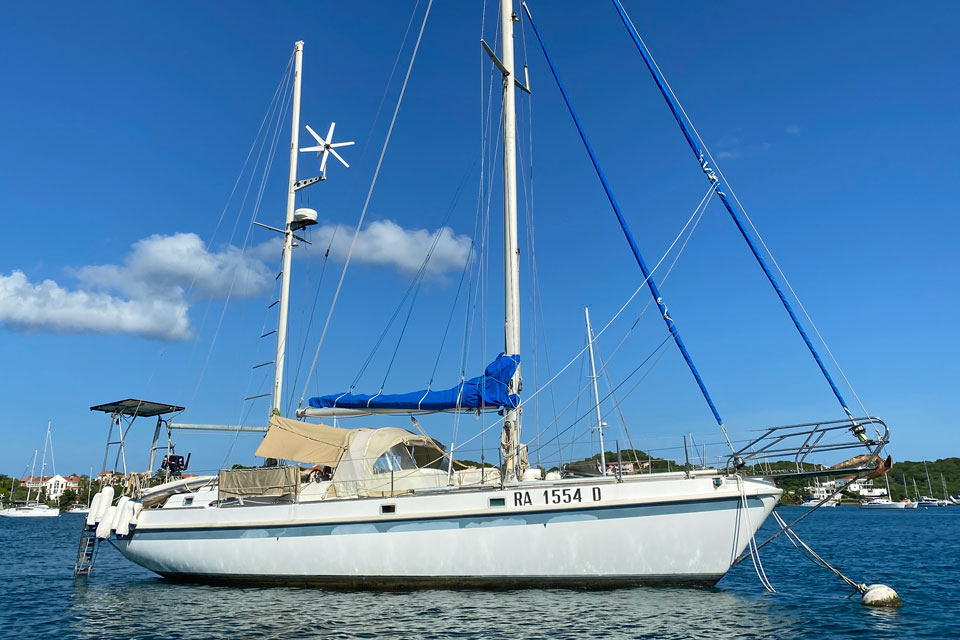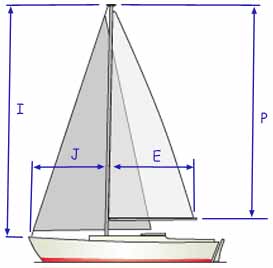- Home
- Cruising Yachts 40' to 45'
- Alan 42 Sailboat Specs
The Apla 42
Specs & Key Performance Indicators
The Apla 42, a moderate displacement staysail ketch, was designed by Sparkman & Stephens and built by Apla Yachts in Italy.
 An Apla 42
An Apla 42Published Specification for the Apla 42
Keel & Rudder Configuration: Fin keel with rudder on skeg
Hull Material: Fiberglass
Length Overall: 12.0m (39'5")
Waterline Length: 9.83m (32'3")
Beam: 3.45m (11'4")
Draft: 1.85m (6'1")
Rig Type: Staysail ketch
Displacement: 12,000 kg (26,455 lbs)
Ballast: 4,500 kg (9,920 lbs)
Water Tank Capacity: 401 litres (106 gallons)
Fuel Tank Capacity: 201 litres (53 gallons)
Hull Speed: 8.2 knots
Designer: Sparkman & Stephens
Builder: Apla Yachts (Italy) - no longer in business
Year First Built: 1973
Number Built: 8
Sail Areas & Rig Dimensions

I: 14.70 meters (48.25 feet)
J: 4.42 meters (14.50 feet)
P: 13.06 meters (42.86 feet)
E: 4.19 meters (13.75 feet)
Total Sail Area: 71m2 (764ft2)
Published Design Ratios
The Key Performance Indicators (KPIs)
The following analysis of the design ratios gives an indication of the boat's likely sailing characteristics, but see the 'Notes of Caution' below:
Sail Area to Displacement Ratio (SA/D): 11.66
This ratio indicates that the Apla 42 is somewhat underpowered. A SA/D below 16 suggests that it will not be particularly quick or offer high performance. This is typical for a cruising sailboat designed more for comfort and stability rather than speed and racing performance.
Ballast to Displacement Ratio (B/D): 37.50%
With a B/D ratio of 37.50%, the Apla 42 doesn't quite meet the threshold for a very stiff and powerful boat, which is typically 40 or more. However, it still indicates a decent level of stability and ability to handle some wind, though it may not stand up to heavy wind as effectively as stiffer designs.
Displacement to Length Ratio (D/L): 222
This places the Apla 42 within the "Moderate Displacement" category (200-275). Moderate displacement boats require a balanced amount of sail area to reach their design hull speed and often offer a good compromise between comfort, performance, and load carrying capacity.
Comfort Ratio (CR): 42.71
A Comfort Ratio of 42.71 suggests that the Apla 42 will have a very sedate motion, typically associated with a heavy bluewater cruising boat. This indicates that the boat will be quite comfortable in terms of its motion, which is less likely to induce seasickness even during heavy seas, making it ideal for long ocean passages.
Capsize Screening Formula (CSF): 1.5
With a CSF of 1.5, the Apla 42 is well below the 2.0 threshold, indicating good bluewater capability. Its lower value suggests a design that is resistant to capsizing, with a beam and displacement that contribute well to stability in open ocean conditions.
Summary
The Apla 42 sailboat is designed more for comfort and stability than speed. It's moderate displacement makes it reasonably easy to achieve its hull speed without requiring excessive sail area. The high Comfort Ratio implies a very comfortable and sedate motion, ideal for long-term cruising. While it is slightly under the desired B/D ratio for maximum stiffness, it still offers respectable stability. The low Capsize Screening Formula confirms that the Apla 42 is well-suited for bluewater sailing, making it a reliable choice for ocean passages. Overall, the Apla 42 is a solid choice for cruisers who prioritize comfort and safety over performance.
Here's how to calculate the KPIs yourself - without having to wrestle with the mathematics...
Design Ratios: Notes of Caution...
- The Sail Area/Displacement Ratio (SA/D): This ratio provides an estimate of the sail power relative to the boat's weight, which can indicate potential speed in various wind conditions. But it doesn't account for the efficiency of the sail plan, the rigging, or the skill of the crew. Real-world performance can vary significantly based on these factors.
- The Ballast/Displacement Ratio (B/D): This ratio gives an idea of the boat's stability and stiffness, which is crucial for handling and safety. But it doesn't consider the distribution of the ballast or the hull shape, both of which can greatly affect stability. A high B/D ratio alone doesn't guarantee a stable boat if the ballast is poorly distributed.
- The Displacement/Length Ratio (D/L): This ratio helps predict the boat's speed potential and its behaviour in different sea conditions. But it doesn't account for the hull design or the boat's overall weight distribution. Two boats with the same D/L ratio can perform very differently if their hull shapes are different.
- The Comfort Ratio (CR): This ratio estimates the boat's motion comfort in a seaway, which is important for long passages. But it doesn't consider the boat's interior layout, which can also affect comfort. Additionally, personal tolerance to motion varies, so a boat that is comfortable for one person might not be for another.
- The Capsize Screening Formula (CSF): This formula assesses the likelihood of a boat capsizing in heavy seas, which is critical for offshore safety. But it doesn't take into account the boat's handling characteristics or the skill of the crew. A boat with a low CSF can still capsize if poorly handled in severe conditions.
General Limitations
- Static Nature: These ratios are static measurements and don't account for dynamic factors like wave action, wind gusts, or crew actions.
- Simplification: They simplify complex interactions into single numbers, which can be misleading. Real-world performance is influenced by a multitude of factors that these ratios can't fully capture.
- Context: The context in which the boat is used (e.g., coastal cruising vs. offshore racing) can greatly affect how these ratios should be interpreted.
In summary, while these ratios provide valuable insights into the theoretical performance characteristics of a sailboat, they should be used as part of a broader assessment that includes practical experience, sea trials, and expert advice.
This article was written with the assistance of Gemini, a large language model developed by Google. Gemini was used to gather information, summarize research findings, and provide suggestions for the content and structure of the article.
Recent Articles
-
Sailboat Wheel Steering Maintenance & Inspection Checklist
Dec 30, 25 02:32 PM
Keep your vessel’s helm responsive and reliable with our expert maintenance checklist. Master cable tensioning and system inspections to avoid mid-passage failures. -
Modern Boat Electronics and the Latest Marine Instruments
Dec 20, 25 05:27 PM
Should sailboat instruments be linked to the latest boat electronics as a fully integrated system, or is it best to leave them as independent units? -
Hans Christian 43: Classic Bluewater Cruiser & Liveaboard Sailboat
Dec 10, 25 04:37 AM
Explore the Hans Christian 43: a legendary heavy-displacement, long-keel sailboat. Read our in-depth review of its specs, design ratios, and suitability for offshore cruising and living aboard.












